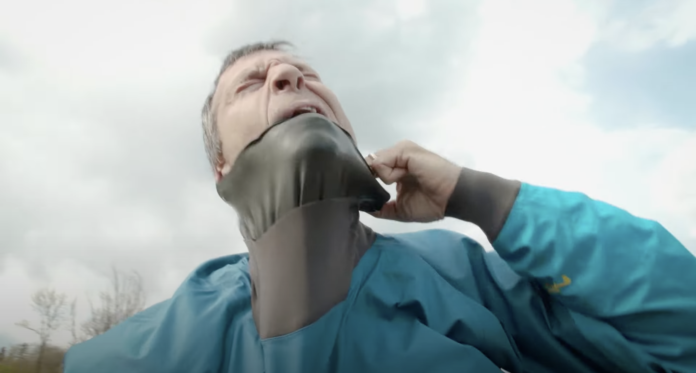4 Tips for Maximizing Longevity and Performance
Dry tops and dry suits are two of the most expensive pieces of paddling gear you can buy. But, if you’re going to be paddling in cold weather and/or cold water, they are hands down the best gear for keeping you warm, comfortable and safe from the very real dangers associated with hypothermia.
Dry Tops vs Dry Suits
Dry tops are paddling tops that have latex gaskets at the neck and wrists that keep you dry as long as you stay in your kayak.
Drysuits are full body suits that will keep you dry even in the event of a swim. While they both do an incredible job at keeping out the cold and wet conditions, if one of your gaskets fails then your dry wear quickly becomes your wet wear.
Thankfully, there are some simple things that you can do to keep your gaskets intact. And so, in this article, I'm going to be giving you tips on how to care for the gaskets on your dry wear.
Types of Gaskets
Before we get started, it's important to differentiate the two basic categories of gaskets. You've got your latex gaskets and your neoprene gaskets. Latex is by far the dryest option. But because it's like having a fat elastic band around your neck, wrists or ankles, some people find it tight and uncomfortable. Neoprene gaskets, on the other hand, are much stretchier, but definitely don't do the same job of keeping the water out. In fact, dry wear that has neoprene gaskets is typically called semi-dry wear.
This article is primarily about latex gaskets, which are much more prone to damage.
Pro kayaking tip #1: take accessories off
Gaskets are most often busted when putting on or removing your dry wear. Sometimes this is simply because they're old, dry, and worn out from a slew of great adventures. But more commonly, they tear because of something you're wearing. In particular, watches kill gaskets. Any hard corner or edge can be the straw that breaks the camel's back. Even if it seems like a smooth watch, take it off before putting your dry wear on.
Be cognizant of rings and especially earrings – the culprits of so many torn gaskets. Finally, something that I discovered back in the day, when I was a long-haired paddling dude, was that hair elastics can be your downfall. I remember being excited to just get out on the water, pulling my dry top down over my head and hrriiipp!…feeling the gasket tear right open. It turns out my elastic had a bit of hard metal on it, and that was enough to cause a rupture.
So you can't be too careful with accessories. When you put on or take off your dry wear, remember to do a body scan first and remove anything on your head, neck, or extremities. You'll save yourself some headaches (and moolah).
Pro kayaking Tip #2: wash your gaskets
The next biggest latex gasket killers are things like sunscreen, bug spray, or any other chemicals you put on your body that can also rub off on the gasket. It's amazing how much of a nightmare that stuff can make of your gear over time. It's not going to deteriorate overnight, but if you leave those chemicals on, they'll slowly turn the latex into a gooey, sticky, useless mess. I personally find bug dope to be a pesky perpetrator. On a cool, spring day, when the bugs are just coming out, I certainly rely on it. I'm not saying to steer clear of these things completely.
But if you are going to be using sunscreen, insect repellant, etc., make sure you wash it off your gaskets at the end of the day. Give them a thorough rinse with soap and water, and then finish off with some 303 protectant.
How often should you use your 303 protectant? Well, it's hard to overdo it. It really depends on how much you're using your dry wear. Full disclosure: I may not be the best person when it comes to taking care of my gear. I tend to spray it on in the spring and then again in the fall, but there are people who use it much more regularly. It really is up to you. Again, you can't clean your gaskets too often. If you're paddling salt water then this is especially true. Make sure to give it a good rinsing with fresh water and then use the 303 to seal it up.
Pro kayaking tip #3: beware of the sun
The third big blower of gaskets is Mr. Sun. Prolonged exposure can damage just about any of your gear. The problem with gaskets, in particular, is they get dried right out. Ultimately, this makes them much more susceptible to cracks and tears. That's why premium dry wear typically has a protective collar around its gaskets. For instance, you'll sometimes see an outer neoprene collar shielding an inner, latex gasket. Note that 303 protectant can also protect against the UV impact. Nonetheless, whatever the circumstances, don't leave your dry wear out in the sun for extended periods of time. You will pay the price.
Those are my tips for maintaining the health of your dry wear. Now let's move on to breaking in your new gaskets, and replacing old ones.
Pro kayaking tip #4: Stretching out and replacing gaskets
When you get a new dry top or drysuit, something that's common is for the gaskets to feel very tight – especially around the neck. In fact, the dry top can feel like it's trying to pop your head like a pimple (oh…another throwback to the greasy-haired, paddling days of my youth). Fear not, that's normal for the first little bit because latex gaskets do stretch over time. Usually after a few full days of use, they'll relax and feel better. But that's not always the case. They do stretch, but sometimes not quite enough. A bit of pre-stretching can save you those first few days of misery, or help to alleviate that last bit of persistent strangulation. Pre-stretching involves putting the gasket over something that’s around the same diameter as your neck, and leaving it there for 24 to 48 hours.
If all else fails, you can actually trim your gaskets to fit better. Since they're shaped like a cone, lopping off a top section will increase the overall diameter. But before taking this drastic measure, beware of a couple things. First, trim in small amounts. Once you cut there's no going back, so just start with a little bit, test it, and then repeat. Secondly, keep in mind that your gasket will stretch with continued use. So don't perfectly tailor it all at once. Leave it a bit taut to allow for that inevitable stretching, which will help maintain an optimal seal. You want it to be a little too snug in the early days.
Next, please note, you have to be super careful when trimming your gasket. Any little nick or tear will become a weak point! Make sure to use very sharp scissors or a precision blade, like an exacto knife. Finally, recruit a friend to help you out. Get them to hold the gasket and apply a bit of tension. This will make it easier to cut. You won't accidentally fold the rubber, and instead you'll make a nice, smooth, straight cut.
Now, if you do try cutting your gaskets and totally botch it, or if your gaskets are just old and failed, don't worry – your dry wear isn't done for. You can get a gasket replaced. Or, you can buy spare gaskets and replace them yourself. In that case, you'll need some Aquaseal and you'll need a helpful, DIY video (there are lots on YouTube like this one). Alternatively, if you're not in a rush to get your dry wear back, you can send it to most manufacturers and they'll replace it for you (for a fee). But I would encourage you to do it yourself. It's not that complicated and it will save you a lot of money and time.
Final thoughts about dry top maintenance
So there you have it, 4 simple tips for prolonging the life and performance of your dry wear, as well as some helpful options for breaking in and repairing your gaskets. If you implement these measures, you'll stay dry and comfortable, and you'll save yourself a lot of hassle, while freeing up your budget for more gear. If you haven't already added some dry wear to your arsenal and you paddle in cold conditions, I highly recommend that you do. It's a huge asset not only on cold days, but in a host of other paddling conditions. It's not only a nice thing to have, it's the safe thing to have!
My favorite Dry Wear:
NRS Crux Drysuit: https://bit.ly/3noFmLA
NRS Flux Dry Top: https://bit.ly/3rcSQLv
Kokatat OM Dry Top: https://bit.ly/3Grh5vS
Kokatat Hydrus Drysuit: https://bit.ly/3nq3Dke
Disclaimer: This article includes affiliate links where Ken Whiting earns a small commission if you make a purchase at no additional cost to you, but it’s a great way to show your support. Thanks!
Other paddling gear I use and recommend
NOTE: These are affiliate links where I’ll earn a small commission if you make a purchase at no additional cost to you, but it’s a great way to show your support. Thanks!
KAYAKS I RECOMMEND
Advanced Elements Advanced Frame
FOOTWEAR
PADDLING SHIRTS / TOPS
NRS H2Core Silkweight Long Sleeve Shirt
NRS Hydroskin Short Sleeve Shirt















